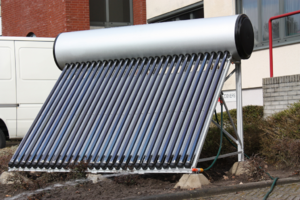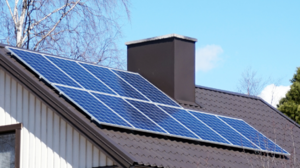Difference between revisions of "Solar Power"
| Line 1: | Line 1: | ||
==Key Stage 3== | ==Key Stage 3== | ||
| + | ===Meaning=== | ||
| + | '''Solar''' is an [[Energy Resource|energy resource]] that uses the [[Energy Transfer|energy transferred]] to the [[Earth]] from [[The Sun]] by [[light]] and [[Thermal Radiation|thermal radiation]]. | ||
| + | |||
| + | ===About Solar=== | ||
| + | : [[Solar]] is a [[Renewable Energy Resource|renewable energy resource]]. | ||
| + | : [[Solar]] has uses [[energy]] in the [[Thermal Energy Store|thermal energy store]] of [[The Sun]] which has been transferred to the [[Earth]] by [[Radiation]]. | ||
| + | |||
| + | ===Power=== | ||
| + | [[Solar]] can be used to provide hot water or generate electricity. | ||
| + | {| class="wikitable" | ||
| + | |- | ||
| + | |[[File:SolarWaterHeater.png|center|300px]] | ||
| + | |[[File:SolarCells.png|center|300px]] | ||
| + | |- | ||
| + | | style="height:20px; width:300px; text-align:center;" |Water is passed through black tubes which [[Absorb (Physics)|absorb]] [[Thermal Radiation|thermal radiation]] from [[The Sun]] to [[heat]] the water. | ||
| + | | style="height:20px; width:300px; text-align:center;" |Light is [[Absorb (Physics)|absorbed]] providing [[energy]] to produce an [[Electrical Current|electrical current]]. | ||
| + | |} | ||
| + | |||
| + | ====Advantages of Solar Cells==== | ||
| + | *Can provide power in places not connected to the national grid. | ||
| + | *Do not produce pollution. | ||
| + | *The running cost is almost nothing. | ||
| + | *No fuel cost. | ||
| + | |||
| + | ====Disadvantages of Solar Cells==== | ||
| + | *Expensive to build. | ||
| + | *Large areas must be covered in cells in order to produce enough electrical power. | ||
| + | *Only work when it’s sunny (not during the night time and slightly less in cloudy weather). | ||
| + | *Cannot increase power output when more is needed. | ||
| + | |||
| + | ==Key Stage 4== | ||
| + | {{#ev:youtube|https://www.youtube.com/watch?v=wiGsba8wVSk}} | ||
===Meaning=== | ===Meaning=== | ||
'''Solar''' is an [[Energy Resource|energy resource]] that uses the [[Energy Transfer|energy transferred]] to the [[Earth]] from [[The Sun]] by [[light]] and [[Thermal Radiation|thermal radiation]]. | '''Solar''' is an [[Energy Resource|energy resource]] that uses the [[Energy Transfer|energy transferred]] to the [[Earth]] from [[The Sun]] by [[light]] and [[Thermal Radiation|thermal radiation]]. | ||
Revision as of 16:28, 13 April 2019
Contents
Key Stage 3
Meaning
Solar is an energy resource that uses the energy transferred to the Earth from The Sun by light and thermal radiation.
About Solar
- Solar is a renewable energy resource.
- Solar has uses energy in the thermal energy store of The Sun which has been transferred to the Earth by Radiation.
Power
Solar can be used to provide hot water or generate electricity.
| Water is passed through black tubes which absorb thermal radiation from The Sun to heat the water. | Light is absorbed providing energy to produce an electrical current. |
Advantages of Solar Cells
- Can provide power in places not connected to the national grid.
- Do not produce pollution.
- The running cost is almost nothing.
- No fuel cost.
Disadvantages of Solar Cells
- Expensive to build.
- Large areas must be covered in cells in order to produce enough electrical power.
- Only work when it’s sunny (not during the night time and slightly less in cloudy weather).
- Cannot increase power output when more is needed.
Key Stage 4
Meaning
Solar is an energy resource that uses the energy transferred to the Earth from The Sun by light and thermal radiation.
About Solar
- Solar is a renewable energy resource.
- Solar has uses energy in the thermal energy store of The Sun which has been transferred to the Earth by Radiation.
Power
Solar can be used to provide hot water or generate electricity.
| Water is passed through black tubes which absorb thermal radiation from The Sun to heat the water. | Light is absorbed providing energy to produce an electrical current. |
Advantages of Solar Cells
- Can provide power in places not connected to the national grid.
- Do not produce pollution.
- The running cost is almost nothing.
- No fuel cost.
Disadvantages of Solar Cells
- Expensive to build.
- Large areas must be covered in cells in order to produce enough electrical power.
- Only work when it’s sunny (not during the night time and slightly less in cloudy weather).
- Cannot increase power output when more is needed.

